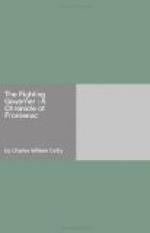His next move likewise involved a new departure. Hitherto the king had discouraged the establishment of forts or trading-posts at points remote from the zone of settlement. This policy was based on the belief that the colonists ought to live close together for mutual defence against the Iroquois. But Frontenac resolved to build a fort at the outlet of Lake Ontario. His enemies stated that this arose out of his desire to make personal profit from the fur trade; but on public grounds also there were valid reasons for the fort. A thrust is often the best parry; and it could well be argued that the French had much to gain from a stronghold lying within striking distance of the Iroquois villages.
At any rate, Frontenac decided to act first and make explanations afterwards. On June 3, 1673, he left Quebec for Montreal and beyond. He accommodated himself with cheerfulness to the bark canoe—which he described in one of his early letters as a rather undignified conveyance for the king’s lieutenant—and, indeed, to all the hardships which the discharge of his duties entailed. His plan for the summer comprised a thorough inspection of the waterway from Quebec to Lake Ontario and official visits to the settlements lying along the route. Three Rivers did not detain him long, for he was already familiar with the place, having visited it in the previous autumn. On the 15th of the month his canoe came to shore beneath Mount Royal.
Montreal was the colony’s farthest outpost towards the Iroquois. Though it had been founded as a mission and nothing else, its situation was such that its inhabitants could not avoid being drawn into the fur trade. To a large extent it still retained its religious character, but beneath the surface could be detected a cleavage of interest between the missionary zeal of the Sulpicians and the commercial activity of the local governor, Francois Perrot. And since this Perrot is soon to find place in the present narrative as a bitter enemy of Frontenac, a word concerning him may fitly be written here. He was an officer of the king’s army who had come to Canada with Talon. The fact that his wife was Talon’s niece had put him in the pathway of promotion. The order of St Sulpice, holding in fief the whole island of Montreal, had power to name the local governor. In June 1669 the Sulpicians had nominated Perrot, and two years later his appointment had been confirmed by the king. Later, as we shall see, arose the thorny question of how far the governor of Canada enjoyed superiority over the governor of Montreal.
The governor of Montreal, attended by his troops and the leading citizens, stood at the landing-place to offer full military honours to the governor of Canada. Frontenac’s arrival was then signalized by a civic reception and a Te Deum. The round of civilities ended, the governor lost no time in unfolding the real purpose of his visit, which was less to confer with the priests of St Sulpice than to recruit forces for his expedition, in order that he might make a profound impression on the Iroquois. The proposal to hold a conference with the Iroquois at Cataraqui (where Kingston now stands) met with some opposition; but Frontenac’s energy and determination were not to be denied, and by the close of June four hundred French and Indians were mustered at Lachine in readiness to launch their canoes and barges upon Lake St Louis.




